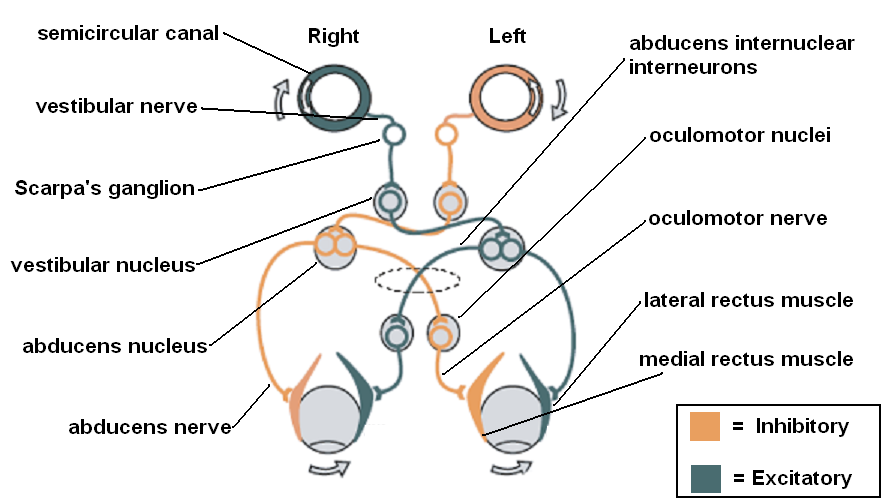[2]
Sherman KR, Keller EL. Vestibulo-ocular reflexes of adventitiously and congenitally blind adults. Investigative ophthalmology & visual science. 1986 Jul:27(7):1154-9
[PubMed PMID: 3487529]
[3]
Lisberger SG, Pavelko TA, Broussard DM. Responses during eye movements of brain stem neurons that receive monosynaptic inhibition from the flocculus and ventral paraflocculus in monkeys. Journal of neurophysiology. 1994 Aug:72(2):909-27
[PubMed PMID: 7983546]
[4]
Bronstein AM, Patel M, Arshad Q. A brief review of the clinical anatomy of the vestibular-ocular connections-how much do we know? Eye (London, England). 2015 Feb:29(2):163-70. doi: 10.1038/eye.2014.262. Epub 2014 Nov 21
[PubMed PMID: 25412719]
[5]
Carleton SC, Carpenter MB. Afferent and efferent connections of the medial, inferior and lateral vestibular nuclei in the cat and monkey. Brain research. 1983 Nov 14:278(1-2):29-51
[PubMed PMID: 6315158]
[6]
Brandt T, Dieterich M. Vestibular syndromes in the roll plane: topographic diagnosis from brainstem to cortex. Annals of neurology. 1994 Sep:36(3):337-47
[PubMed PMID: 8080241]
[7]
Wallace B, Lifshitz J. Traumatic brain injury and vestibulo-ocular function: current challenges and future prospects. Eye and brain. 2016:8():153-164. doi: 10.2147/EB.S82670. Epub 2016 Sep 6
[PubMed PMID: 28539811]
[8]
Spencer RF, Porter JD. Biological organization of the extraocular muscles. Progress in brain research. 2006:151():43-80
[PubMed PMID: 16221585]
[9]
Curthoys IS, Halmagyi GM. Vestibular compensation: a review of the oculomotor, neural, and clinical consequences of unilateral vestibular loss. Journal of vestibular research : equilibrium & orientation. 1995 Mar-Apr:5(2):67-107
[PubMed PMID: 7743004]
[10]
Han BI, Song HS, Kim JS. Vestibular rehabilitation therapy: review of indications, mechanisms, and key exercises. Journal of clinical neurology (Seoul, Korea). 2011 Dec:7(4):184-96. doi: 10.3988/jcn.2011.7.4.184. Epub 2011 Dec 29
[PubMed PMID: 22259614]
[11]
Perez Fornos A, Guinand N, van de Berg R, Stokroos R, Micera S, Kingma H, Pelizzone M, Guyot JP. Artificial balance: restoration of the vestibulo-ocular reflex in humans with a prototype vestibular neuroprosthesis. Frontiers in neurology. 2014:5():66. doi: 10.3389/fneur.2014.00066. Epub 2014 Apr 29
[PubMed PMID: 24808890]
[12]
Fife TD, Tusa RJ, Furman JM, Zee DS, Frohman E, Baloh RW, Hain T, Goebel J, Demer J, Eviatar L. Assessment: vestibular testing techniques in adults and children: report of the Therapeutics and Technology Assessment Subcommittee of the American Academy of Neurology. Neurology. 2000 Nov 28:55(10):1431-41
[PubMed PMID: 11094095]
[13]
Eckhardt-Henn A, Breuer P, Thomalske C, Hoffmann SO, Hopf HC. Anxiety disorders and other psychiatric subgroups in patients complaining of dizziness. Journal of anxiety disorders. 2003:17(4):369-88
[PubMed PMID: 12826087]
[14]
Cha YH, Lee H, Santell LS, Baloh RW. Association of benign recurrent vertigo and migraine in 208 patients. Cephalalgia : an international journal of headache. 2009 May:29(5):550-5. doi: 10.1111/j.1468-2982.2008.01770.x. Epub 2009 Jan 16
[PubMed PMID: 19170697]
[15]
Takahashi M, Okada Y, Saito A, Takei Y, Tomizawa I, Uyama K, Takeuti I, Kanzaki J. Roles of head, gaze, and spatial orientation in the production of oscillopsia. Journal of vestibular research : equilibrium & orientation. 1990-1991:1(3):215-22
[PubMed PMID: 1670155]
[16]
Kaminski HJ, Leigh RJ. International Symposium for Therapy of Ocular Motility and Related Visual Disturbances. Neurology. 1997 May:48(5):1178-84
[PubMed PMID: 9153439]
[17]
Guinand N, Pijnenburg M, Janssen M, Kingma H. Visual acuity while walking and oscillopsia severity in healthy subjects and patients with unilateral and bilateral vestibular function loss. Archives of otolaryngology--head & neck surgery. 2012 Mar:138(3):301-6. doi: 10.1001/archoto.2012.4. Epub
[PubMed PMID: 22431876]
[18]
Lambert S, Sigrist A, Delaspre O, Pelizzone M, Guyot JP. Measurement of dynamic visual acuity in patients with vestibular areflexia. Acta oto-laryngologica. 2010 Jul:130(7):820-3. doi: 10.3109/00016480903426592. Epub
[PubMed PMID: 20082568]
[19]
McGarvie LA, MacDougall HG, Halmagyi GM, Burgess AM, Weber KP, Curthoys IS. The Video Head Impulse Test (vHIT) of Semicircular Canal Function - Age-Dependent Normative Values of VOR Gain in Healthy Subjects. Frontiers in neurology. 2015:6():154. doi: 10.3389/fneur.2015.00154. Epub 2015 Jul 8
[PubMed PMID: 26217301]
[20]
Gonçalves DU, Felipe L, Lima TM. Interpretation and use of caloric testing. Brazilian journal of otorhinolaryngology. 2008 May-Jun:74(3):440-6
[PubMed PMID: 18661020]
[21]
Wijdicks EF. Determining Brain Death. Continuum (Minneapolis, Minn.). 2015 Oct:21(5 Neurocritical Care):1411-24. doi: 10.1212/CON.0000000000000221. Epub
[PubMed PMID: 26426238]
[22]
Meneses E, Sampaio A, Venosa A, Tauil P, Dias M, Oliveira C. Vestibulo-ocular reflex as predictor of cerebral death in comatose patients. The international tinnitus journal. 2010:16(1):8-13
[PubMed PMID: 21609907]
